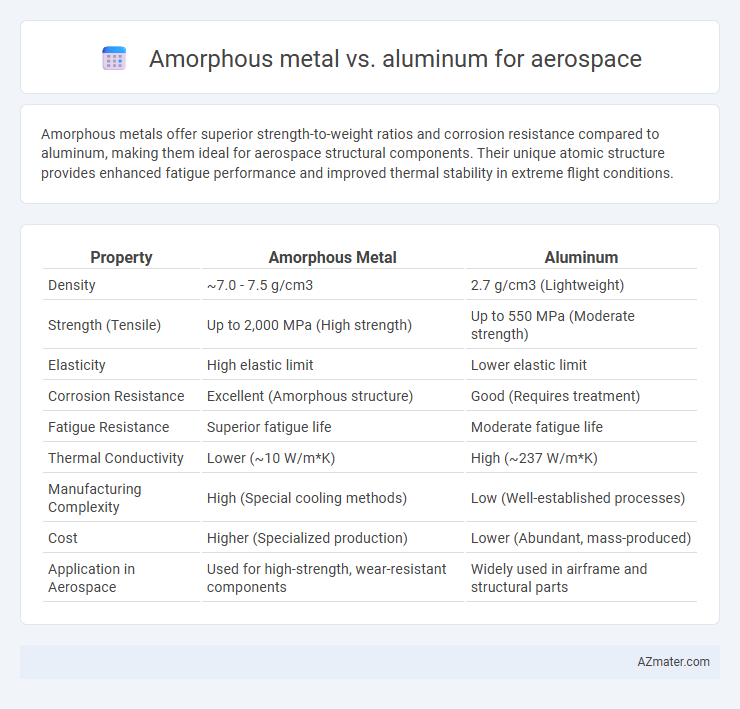Amorphous metals offer superior strength-to-weight ratios and corrosion resistance compared to aluminum, making them ideal for aerospace structural components. Their unique atomic structure provides enhanced fatigue performance and improved thermal stability in extreme flight conditions.
Table of Comparison
| Property | Amorphous Metal | Aluminum |
|---|---|---|
| Density | ~7.0 - 7.5 g/cm3 | 2.7 g/cm3 (Lightweight) |
| Strength (Tensile) | Up to 2,000 MPa (High strength) | Up to 550 MPa (Moderate strength) |
| Elasticity | High elastic limit | Lower elastic limit |
| Corrosion Resistance | Excellent (Amorphous structure) | Good (Requires treatment) |
| Fatigue Resistance | Superior fatigue life | Moderate fatigue life |
| Thermal Conductivity | Lower (~10 W/m*K) | High (~237 W/m*K) |
| Manufacturing Complexity | High (Special cooling methods) | Low (Well-established processes) |
| Cost | Higher (Specialized production) | Lower (Abundant, mass-produced) |
| Application in Aerospace | Used for high-strength, wear-resistant components | Widely used in airframe and structural parts |
Introduction to Aerospace Materials
Amorphous metals, also known as metallic glasses, exhibit exceptional strength, high elastic limits, and excellent corrosion resistance compared to traditional aerospace materials such as aluminum alloys. Aluminum remains widely used in aerospace due to its low density, good thermal conductivity, and established manufacturing processes, but amorphous metals offer potential advantages in fatigue resistance and wear properties. The integration of amorphous metals into aerospace applications can lead to lighter, more durable components that enhance overall aircraft performance and efficiency.
Overview of Amorphous Metals
Amorphous metals, also known as metallic glasses, exhibit a non-crystalline atomic structure that provides superior strength, elasticity, and corrosion resistance compared to conventional aluminum alloys in aerospace applications. Their unique disordered atomic arrangement contributes to enhanced wear resistance and higher fatigue limits, making them ideal for critical aerospace components requiring lightweight durability. Despite higher production costs, amorphous metals offer significant performance advantages over aluminum, particularly in structural parts subjected to extreme stress and temperature variations.
Properties of Aluminum in Aerospace
Aluminum is widely used in aerospace due to its high strength-to-weight ratio, excellent corrosion resistance, and good machinability, which contribute to fuel efficiency and structural durability. Its properties include a melting point around 660degC, thermal conductivity of approximately 237 W/m*K, and density near 2.7 g/cm3, making it lightweight yet robust for aircraft components. Aluminum alloys such as 2024 and 7075 provide enhanced mechanical properties, supporting structural applications like wings, fuselage, and engine components in aerospace engineering.
Mechanical Strength Comparison
Amorphous metals exhibit significantly higher mechanical strength and hardness compared to aluminum alloys used in aerospace, often surpassing tensile strength values of 1,500 MPa versus aluminum's 300-600 MPa range. The non-crystalline atomic structure of amorphous metals contributes to superior fatigue resistance and improved elastic limits, making them ideal for high-stress aerospace components. While aluminum offers excellent weight-to-strength ratios and corrosion resistance, the enhanced mechanical properties of amorphous metals provide potential for advanced structural applications requiring higher durability.
Weight and Density Considerations
Amorphous metals exhibit lower density ranges between 7.2 to 7.4 g/cm3 compared to aluminum alloys, which typically have densities around 2.7 g/cm3, making aluminum significantly lighter for aerospace applications. Despite higher weight, amorphous metals offer superior strength-to-weight ratios and enhanced fatigue resistance, potentially offsetting the weight penalty in critical structural components. Weight savings from aluminum drive fuel efficiency and payload performance, but integrating amorphous metals targets durability in high-stress aerospace environments where density is balanced against mechanical advantages.
Corrosion Resistance Performance
Amorphous metals exhibit superior corrosion resistance compared to aluminum, making them highly advantageous in aerospace environments exposed to moisture, salt, and extreme temperatures. Their non-crystalline atomic structure eliminates grain boundaries, which are common corrosion initiation sites in aluminum alloys. This results in enhanced durability and longer lifespan for aerospace components, reducing maintenance costs and improving overall safety.
Manufacturing and Processing Techniques
Amorphous metals offer superior strength and corrosion resistance compared to aluminum, enabling the production of lighter and more durable aerospace components through advanced manufacturing techniques like rapid solidification and additive manufacturing. Aluminum remains favored for its well-established processing methods such as extrusion, casting, and machining, which provide cost-effective and scalable production for structural parts. The adoption of amorphous metals in aerospace manufacturing is growing due to innovations in thermoplastic forming and controlled cooling, which overcome previous challenges related to their brittleness and complex shaping.
Cost Analysis and Scalability
Amorphous metals offer superior strength-to-weight ratios compared to aluminum, potentially reducing overall aerospace component weight and fuel costs, but their high production costs and complex manufacturing processes limit immediate cost-effectiveness in large-scale applications. Aluminum remains a cost-efficient and scalable material due to established supply chains, lower raw material costs, and mature manufacturing techniques, supporting mass production and widespread aerospace use. Evaluating aerospace projects requires balancing the upfront material and fabrication expenses of amorphous metals against the long-term performance and weight savings benefits relative to the proven cost scalability of aluminum.
Applications in Aerospace Engineering
Amorphous metals exhibit superior strength-to-weight ratios and enhanced corrosion resistance compared to traditional aluminum alloys, making them ideal for aerospace components subjected to extreme stress and temperature variations. Their exceptional wear resistance and magnetic properties contribute to the development of more efficient actuators and sensors in aerospace systems. Although aluminum remains widely used for structural parts due to its cost-effectiveness and ease of fabrication, amorphous metals are increasingly integrated into aerospace engineering for high-performance applications requiring durability and precision.
Future Prospects and Innovations
Amorphous metals offer superior strength-to-weight ratios and improved corrosion resistance compared to aluminum, making them promising candidates for aerospace structural components. Innovations in additive manufacturing and alloy design are enabling the production of complex, lightweight amorphous metal parts that enhance fuel efficiency and durability in next-generation aircraft. Future aerospace applications increasingly rely on these advancements to reduce overall weight while maintaining high performance under extreme operating conditions.

Infographic: Amorphous metal vs Aluminum for Aerospace
 azmater.com
azmater.com